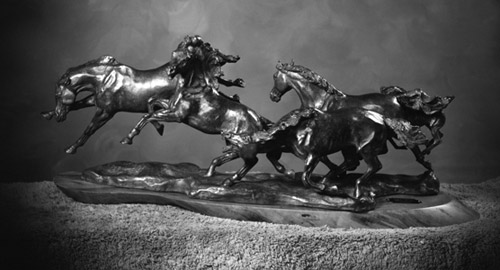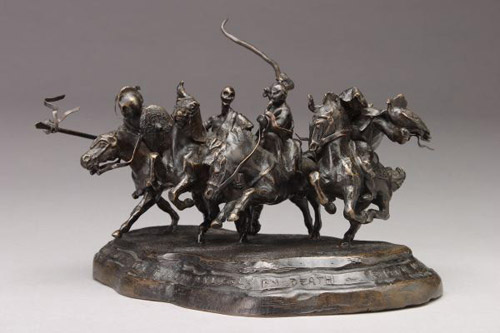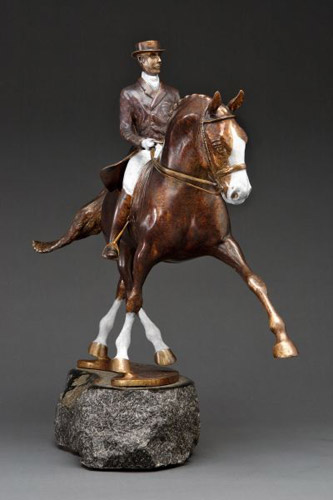 Name
Name
My name is Sara Mall Johani. I sign my work simply Sara. There’s a story behind it which conveys volumes to me that it’s enough. I try to keep it simple, and, as we all know, life is anything but simple.
Website & Places you can find my work online
Our main website is www.thelateralline.com. My husband and I are a team and do a lot of (art) work together, filling in the gaps with whatever our skills and strengths allow.
So there’s another project site http://soulsalmon.org, it was a very intense community non-profit effort something like the cows in Chicago and a lot of different fiberglass creatures around the world. See the interactive art parade map
We also participated as artists in a Watershed oriented art retreat where we were asked to relate to the Wenatchee watershed and its creature inhabitants along with other artists.
Where I am
I live in Chimacum, WA in the Pacific Northwest, the place with tall conifers and teeming salmon. At least they used to “teem”. We were engaged for years bringing them back, yet it’s still an unresolved issue whether the wild fish will survive sustainably.

Tell us a little about you, what is your background & where do you come from?
My ethnic background is Estonian and I grew up speaking Estonian at home. I was born in Lund, in the south of Sweden and when my family moved to Canada when I was five, I went too.
I studied Education in college and worked as a teacher for one year but I wasn’t suited to it. Fortunately I had anticipated that eventuality and had made a point of paying for my first car, a VW Bug, with the proceeds of the first ten month work period so I didn’t have to go back.
I had been lucky to be given opportunities in art instruction, life drawing and sculpting, in the Royal Ontario Museum where I spent many happy years but I wasn’t able to imagine life as an artist in Canada. I felt, at the time, that it was only for well connected or wealthy individuals.
So, when I came to the United States in the early seventies I started working in artistic endeavors immediately. It may be that the 30 times greater population provided a rationale for my feeling that there was a more realistic opportunity here.
When did you first start sculpting?
Just like all the rest of the artists I read about, I loved horses and sculpting from the earliest days.
Of course I didn’t know what that meant at the time but I clearly remember sculpting my first horse, trotting, at age 7 or 8. Maybe it was six. I made my first fired ceramic at age twelve and I still have that piece, a glazed white lioness lying on her side. It was instant lifelong engagement.
What is your favorite animal to sculpt?
What could it be?! I was crazy about horses from a very early age. I loved their dynamism, energy, willingness and affection. It always breaks my heart to see a horse do amazing things just because they are asked – like run their heart out, strain over jumps or so utterly willingly obey complex dressage commands.
After concentrating on sculpting horses all through my youth I didn’t sculpt horses for many years after I had a child, even decades and, as I mentioned above, did a lot of community environmental work. I was creative primarily for the community for several years and I feel it was necessary for me to widen my world view, skills and grasp as well as create a living community for the children.
I learned how difficult human portrait sculpture was and also learned to love the challenge. (I had made a living for many years doing horse portraits, both graphics and sculpts). I think I needed to deepen to undertake my personal creative calling. I’m so thrilled and pleased to be sculpting horses again. It came as a surprise, which I’ll explain in the answer to a later question.

How long does it take to complete a piece?
After our son graduated from college I decided to dedicate myself primarily to sculpture in bronze which I consider my first calling.
Bronze is an interesting, almost grueling process requiring stamina and persistence.
Since we cast our own work, the WORK aspect of the process is a larger part of it than normally when the sculpture is sent out to be cast and finished. My husband is a foundryman and has cast very large art castings for decades. Now we just cast our own pieces.
I’d say the usual duration for a regular tabletop size piece is a few months. Bronze can be ruined at any stage, even at the very end so it’s with great care that we negotiate the steps of molding, spruing, investing, pouring, breakout and chasing. We love it and it’s our choice, very satisfying.
Do you (or did you) have an animal that is the muse behind your work?
Yes, I had a lengthy relationship with a colt who grew up to be a horse that lived for 38 years. He was a stallion for 9 years and sired several Anglos. He was an Arab named Star in Bronze. I called him “Might”, like Mighty Mouse, I guess. He was a bronze chestnut with a star and one bit of white on a pastern.
He was a great friend and outlasted many other relationships since he lived so long. I kept track of his spontaneous gallops in the large field he occupied especially after he had become aged. He galloped all out three days before he passed away. He was a healthy, energetic, responsive, intelligent creature and after he was gone for a year I decided I could treat myself to the World Cup in dressage, my favorite sport, in order to commemorate his life.
That’s when I discovered I still could “see” the horse, I had forgotten nothing even though it had been 25 – 30 years. I started to sculpt horses again with the portrait of “Briar & Brink”.

Do you have any secret rituals you do to help you get in the zone for your art?
My only secret is to be true to myself, firmly honest and realistic in my outlook, believe in what I perceive and assimilate all the lessons life provides without deviation or denial. Without that my creativity would not be available to me. It’s the reward.
Is there a particular place that brings you inspiration?
I do love the Pacific Northwest where I feel more at home than anywhere else in the world. I have found my “place”, a compatible haven and I guess that’s pretty important overall.
I’m not sure that’s the direct inspiration that you’re asking about but if I didn’t feel settled and comfortable in my skin and surroundings I doubt that I could work. I’m SO THANKFUL to be inspired and able.
I can’t imagine working creatively without grace, that mysterious gift from somewhere beyond.

What effect do you think the Internet will have on art in general?
The Internet is an amazing connector. My husband is a self proclaimed Neo-Luddite and I see that he misses a lot of interaction, some of it close and important. I can stay in intimate contact with far off relatives and friends as easily as if they were present.
I love the opportunity to research and view hundreds of images and concepts from around the world. My community projects have gained access and recognition because of the web. I can tune in to opportunities like RFP’s (requests for proposals) tapping in to opps that would be impossible to imagine otherwise. Of course, the obvious sales to far off places bloom through the net, can’t deny that.
But I worry slightly and wonder if the net is sustainable. Hard to imagine, we’re so tuned in, aren’t we? I’m afraid I can’t tell what the overall effect will be on art. There may be unintended consequences, usually there are, I think. I hope it doesn’t trivialize art.
Has it had an effect on yours?
Since we are quite tuned in to locality and the community that surrounds us, perhaps not as much as for others. I deeply believe that the local community is the best and most important human connection and safety net we have access to.
As someone said once – I think it was Bill Mollison, the permaculture founder – “No more net-working; now let’s have work-netting”. Networking is what the Internet does very well, it seeks out similarities of interest. Worknetting is what happens in local community. It’s personal, diverse, intimate and inclusive – even the crazy uncle is part of it.
I’m not knocking the Internet, I love it, but I wonder about considerations we love to deny. There’s danger in too many freedoms and tangents. Chaos is a danger.

Which one is your personal favorite piece?
I recently finished a piece I started 34 years ago. It was called the FLYING HORSE OF KANSU at the time but the K became a G meanwhile. Now it’s Gansu. I copied it for edification purposes after being bowled over by the display in San Francisco at the People’s Republic of China Archaeological FInds exhibit.
It was the hit of the show and later has become the symbol for tourism in all of China. I made sketches, noting the twist in the head of the horse, galloping and neighing, balancing on one foot on the back of a swallow looking up in surprise to see a horse in flight. I’m in the midst of making the mold for it now and I can’t wait to see how it turns out in bronze. It’s totally an inspiration, a masterpiece.
It was quite difficult to participate in this older way of learning, by copying masterful works. I didn’t know how hard it was to follow someone else’s patterns until I tried it with a couple of pieces – the Gansu horse and the Venus of Willendorf which I enlarged in the process.
The Venus is a knockout masterpiece! That’s the oldest full figure human sculpture known – almost 30 thousand years old!
Would you ever sell it?
I’m a little afraid to even have copied the Flying Horse since clearly it’s a copyrighted image (although I might object to ancient pieces having copyright; I think they belong to all of us). Still, realities are realities – I don’t want to mess with China! It would have to be a private event, I suppose.
Since bronze is usually sold in editions it’s one of the few situations where one can have the cake and eat it too.
What else are you passionate about?
I seem to be passionate about everything I encounter lately. I have so many creative ideas it’s downright ridiculous. Now that time is short, being 63 already, I must accomplish huge amounts of work in order to come close to everything I have planned.
Fortunately I have gained a certain dogged perseverence in my capacity to gain ground so I keep working, be it in the foundry helping teach our bronze casting class, in the studio sculpting, chasing or making mold etc or in the house, at night, making jewelry.
Freedom to work, that’s my blessing. Even watching a film on TV is an opportunity to relax and work.

Working on anything new?
I have finished sculpting a large public commission of a full figure life size portrait of Harvey Manning. Now we are into the laborious aspect of sculpting in order to install by the September deadline – molding, casting, welding the puzzle together, making it look right again.
Also, I just found a new RFP to respond to, a perfect fit for a project I had developed previously so I’m excited about the possibilities. However, I am most enthusiastic about several new series of small sculptures of horses (and a ridden rhinoceros)! I literally can’t wait to get at them. They are already cast, waiting outside while the rain gently scrubs them clean so I can finish them (saw off sprues, chase the surface with files, chisels and hammers etc). The series are called “Galloping Graphics”, “Extreme Equipoise” and “RISK”. Can’t wait!
More to Come
Thanks to Sara for answering the interview and sharing her art. Be sure to check back to her bronze art website for updates about her latest works.
Also stay tuned for more interviews with horse artists and photographers.
Are you a horse artist or do you know an equine artist you’d like to see featured? Add your name and website in the comments below or drop me a note to get involved.

Wow. I am just blown away by this – feel like I’ve literally been in the studio with Sara. I love the pieces and am invigorated! Thanks so much!
Really glad to have found this site. Thankyou for sharing your art and your thoughts, Sara. I really love the standing horse with its head looking back.
Thanks again
what size is the four horseman and how much for one of these
please send your anser to my email add.